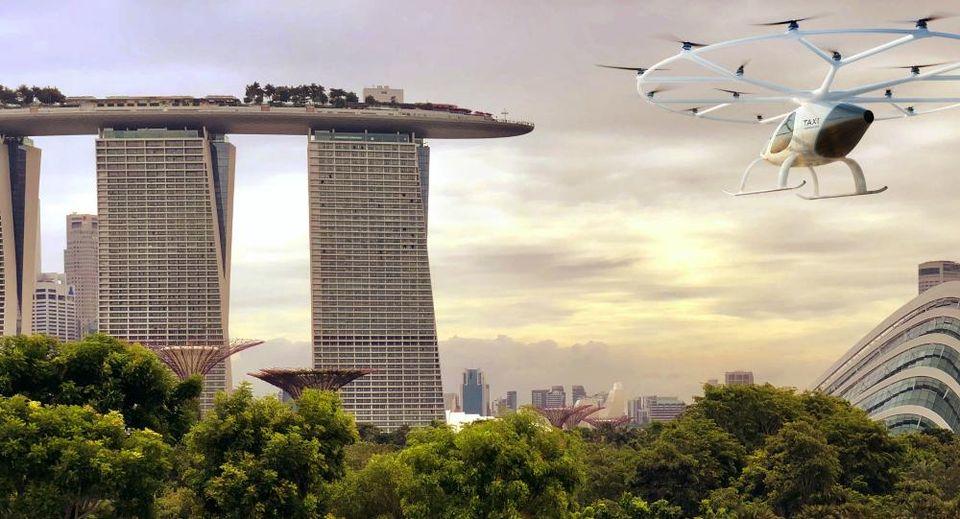
SINGAPORE - The prospects of urban air mobility (UAM) flights in Singapore took a key step forward on Feb .12 with the signing of an agreement between Airbus and the island state’s Civil Aviation Authority (CAAS) to improve regional connectivity.
The deal with Airbus, which builds on an earlier agreement established in 2016 between the aircraft maker and CAAS for proof-of-concept trials of a cargo-carrying Skyways unmanned air system, lays the foundations for potential services with both passenger and larger cargo carrying vehicles throughout Singapore.
Under the memorandum of understanding, Airbus and CAAS will develop an unmanned traffic management (UTM) system to support the early phase of the air mobility service. The two will also collaborate on developing a framework for safety and operating standards as well as study issues such as public acceptance.
“Skyways was a laboratory for UAM at a smaller scale. Now we need to go the extra mile, so with this agreement we are doing that,” says Jean-Brice Dumont, executive vice president of engineering for Airbus. “There are still questions of the business case and technology. In terms of business, we can see an appetite in the market, even though it’s a niche right now for more emergency needs where time is of the essence or where its value-added, like shore-to-ship deliveries.”
Under the Skyway program a quadcopter drone initially delivered parcels in the campus of the National University of Singapore and later carried a 1.5 kg. cargo load of 3D printed parts from Marina South Pier in Singapore to a ship 1.5km offshore. Further trials have been performed with a 4kg payload Skyways drone, which navigated autonomously along pre-determined aerial corridors to vessels up to 3km from the coast, says Airbus, which claims up to 90% savings in delivery costs and up to six times higher delivery speeds than with boats.
Technology studies will focus on traffic management as well as “the overall system, guarantees, performance, safety and cost,” says Dumont. “We are flying with a couple of vehicles and in that sense, we are already there. But when you are flying with 20 or 100 vehicles at the same time along given routes then you are defining a system and that’s what we are doing with UTM.”
“We are at the stage of reviewing the collaboration mostly because of the safety aspect,” says Leo Jeoh, head of the UTM Lab Urban Air Mobility for Airbus Singapore. “It’s about designing a system of systems that would have the requisite safety level for an urban application, so to do that in 2016 we had CAAS as a partner. It gave us the areas to operate in and representative areas and helped us identify the safety requirements.”
“Now we are defining what comes next,” says Jeoh. “We know we have technological gaps such as UTM so we have a big team working on that, and we have the opportunity for tests in live space and a flying vehicle so we can test some of that,” he adds.
Airbus also continues to evaluate what sort of electric vertical take-off and landing (eVTOL) vehicle, or vehicles, to develop for the emerging UAM market. However, the agreement with CAAS points to a potential early pathway to passenger service through initial freight services of larger cargo-carrying vehicles than the small Skyways drone. “On the passenger vehicle side of the house you may see it first with cargo,” confirms Dumont. “The good thing about cargo is you can start small and scale it up.”
“We have learned a lot with Vahana and are still flying with City Airbus,” he adds referring to the recently completed flight campaign of the autonomous eVTOL demonstrator in the U.S. and continuing tests of the company’s CityAirbus, a larger four-seat design with four ducted coaxial rotors that made its first hover flight in Germany last May. The Vahana project was aimed mainly at demonstrating autonomy, while CityAirbus is focused principally on electric propulsion. “You see every type of vehicle design out there but I believe if one were right everyone else would have followed,” says Dumont. “It’s a very interesting question. The helicopter formula hasn’t changed in 70 years, but what is the right one to crack the nut of air mobility? That’s the trip we are on.”
The Airbus-Singapore agreement comes on the heels of a similar memorandum of understanding between Bell, Japan Airlines and Sumitomo Corp. to explore on-demand air mobility services in Japan. The study, which centers on the use of the recently unveiled Nexus 4EX eVTOL, will address air mobility studies as well as the required infrastructure and regulatory environment.
